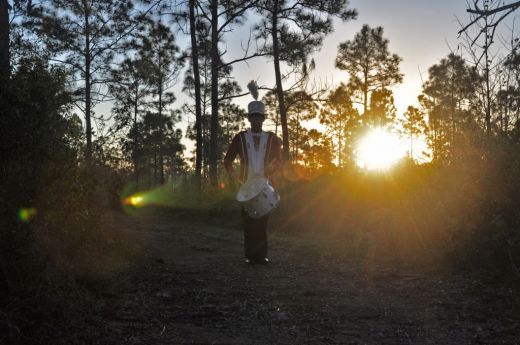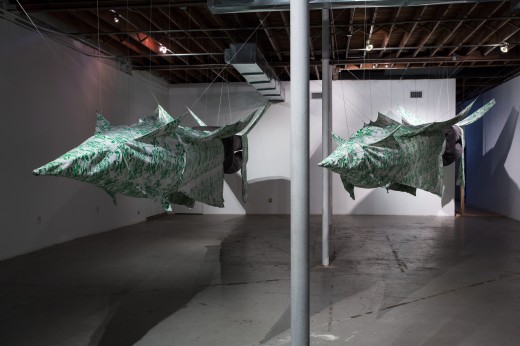Christy Gast, Inholdings
Hunter Braithwaite

Still from Christy Gast's "War Drums (Nuclear Clock)"
March 8 – April 21, 2014
An inholding is a piece of private land completely surrounded by publicly owned, protected land. That is ostensibly what this show is about—a chunk of land in the Everglades called the Hole in the Donut and the struggles of power and aggression that have happened there over the past half-century or so—but it is also a metaphor for Christy Gast’s way of working, and for how myths get started and spread and, in the end, believed. See, the centers of our most-told tales are always off limits, hidden somehow, private. Yet Gast gets to them.
When the viewer enters Locust Projects, a mutating military tattoo cracks out of a video in the front gallery, “War Drums (Nuclear Clock).” The camera slowly spins, creating a clockwise flow that features, in turn, two drummers beating out two rhythms. The nature of those rhythms, and the costumes, however, are as much at odds as the drummers themselves, who face each other at firing-squad distance. One is dressed in traditional costume, and explores the organic sounds of an Afro-cuban beat on the congas. The other is dressed in a military-styled marching band uniform. He’s rat-ta-tatting a marching cadence on a snare. As these two sounds tangle, it’s like ivy pushing through a chain-link fence. Gast wrote the score for this performance, which took place at dawn in wilderness only an hour away from Miami. And while the passage of time marked by each drum beat seems to bring us closer to annihilation, the video itself is a pleasant reminder of how many things she can do well.

Installation View of Christy Gast’s Inholdings
We have the makings of a tight narrative, a story of Florida from the shrubs to missile-streaked skies. One could say that, by decorating a Cold-War era nuclear weapon with an invasive species of plant, Gast suggests a connection between ecology and politics, between nature and culture, with human folly and ambition as the hole in the donut. The problem with a tight narrative is that it’s a story, one that doesn’t necessarily depend on objects. And this is the razor’s edge that Christy walks. How can her sculptures stand up to the immensely fascinating backstories? How can they hold their own? They hold their own, in part, because of the backstories. Using textiles such as burlap, quilts, and here, military canvas, she specifically chooses fabrics that evoke certain memories or ways we approach our history and the country. This exhibition progresses as a narrative, but only as much as it expands like an environment, a country within itself, a place both public and private.










